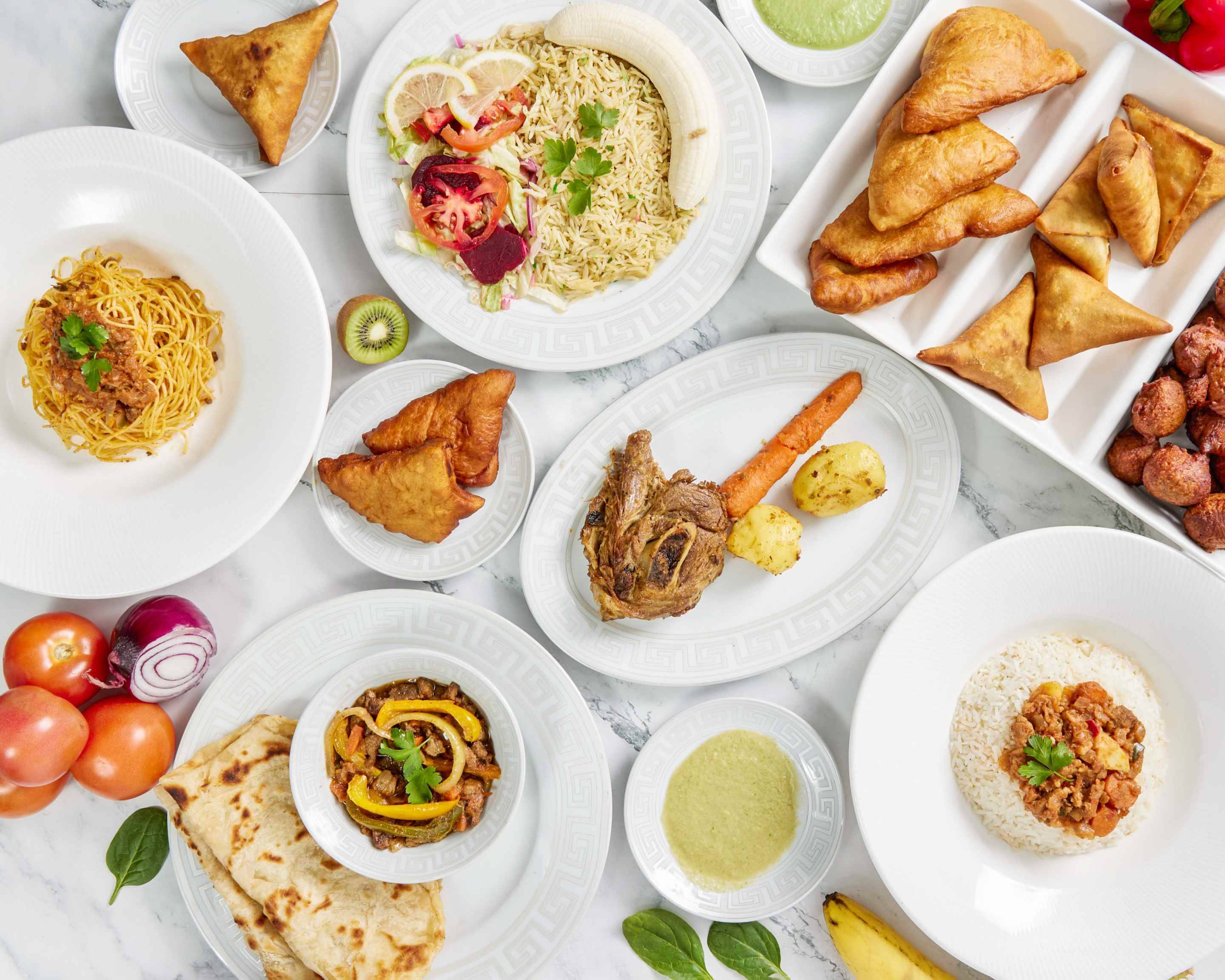Relish the very best Somali Food: Uncover Cooking Prizes and Tastes
Wiki Article
Relishing the Unique Tastes and Flavors of Somali Gastronomy: a Trip Through the Land of Spices and Saffron

Aromatic Flavors and Saffron
Somali food is understood for its delicious and bold recipes, which are achieved through the experienced use of aromatic flavors (Somali food). These fragrant seasonings are utilized in both typical and contemporary Somali recipes, creating an one-of-a-kind and extraordinary flavor account.One of the most treasured seasonings in Somali food is saffron. Known for its dynamic color and unique aroma, saffron is frequently utilized to raise and improve the tastes of Somali meals. Whether it's sprinkled on rice pilaf, instilled in warm tea, or utilized in stews and curries, saffron includes a touch of deluxe to Somali gastronomy.
Along with their culinary relevance, these fragrant flavors and saffron also hold social relevance in Somali food. They are used in traditional celebrations and events, symbolizing heat, hospitality, and the splendor of Somali society.
Conventional Somali Recipes
Discover the mouth-watering array of standard Somali dishes that will transport you to a world of strong tastes and cultural richness. Somali cuisine is a wonderful combination of African, Middle Eastern, and Indian influences, causing a special culinary experience. One legendary dish is the Somali rice, called "Bariis." Aromatic basmati rice is prepared with aromatic spices, such as cardamom, cinnamon, and cloves, providing it a warm and inviting fragrance. Another must-try recipe is "Suqaar," a stir-fry of tenderized meat or chicken, onions, garlic, and a collection of seasonings. The meat is cooked up until it is delicious and bursting with flavor. For those seeking a vegan option, "Iskudhehkaris" is a wonderful selection. This meal features a mix of potatoes, carrots, peas, and rice, cooked in a flavorful tomato-based sauce. Somali food likewise flaunts tasty flatbreads, such as "Canjeero" and "Injera," which are ideal for scooping up stews and sauces. No Somali meal is full without a cup of spiced tea, understood as "Shaah." It is made with black tea leaves, cardamom sheaths, cinnamon sticks, and a touch of cloves, creating a cozy and comforting beverage. Start a cooking experience and enjoy the diverse and abundant tastes of conventional Somali recipes.Impacts From Arab and Indian Cuisine
Immerse yourself in the lively tastes of Somali gastronomy as you uncover the rich influences from Arab and Indian cuisine. Somali food has actually been shaped by centuries of trade and cultural exchange with Arab and Indian merchants. These influences can be seen in the diverse flavors, flavors, and cooking methods used in Somali meals.Arab cuisine has had a considerable influence on Somali gastronomy. Somali recipes often include active ingredients such as cardamom, cinnamon, cloves, and saffron that are frequently utilized in Arab cooking. The usage of these seasonings includes depth and complexity to Somali recipes, producing a distinct flavor account.
Somali meals usually incorporate flavors such as turmeric, cumin, and coriander, which are typically made use of in Indian food preparation. These seasonings not just add flavor but also provide Somali meals their vivid colors.
In enhancement to seasonings, Arab and Indian culinary techniques have additionally influenced Somali cooking. The idea of slow food preparation or marinating meat in seasonings before barbecuing, called "maraq," is thought to have stemmed from Arab cuisine. In a similar way, making use of flatbreads, like "canjeero," which resembles Indian dosa, can be mapped back to Indian cooking customs.
The impacts from Arab and Indian food have actually included deepness and complexity to Somali gastronomy. These impacts have not just formed the components and tastes used in Somali recipes but have additionally added to the cultural identification of Somali food. So, as you embark on your cooking journey with Somali gastronomy, be prepared to relish the special tastes and flavors that have actually been affected by Arab and Indian cuisine.

Discovering Regional Flavors
As you dig into the diverse cooking landscape of Somali gastronomy, a multitude of regional flavors awaits your taste. Each area in Somalia flaunts its own one-of-a-kind active ingredients, cooking techniques, navigate to this site and flavor mixes that add depth and range to the country's cuisine.In the north region of Somalia, you will certainly discover tastes influenced by the nomadic way of life and closeness to the Gulf of Aden. Below, camel meat takes spotlight, prepared in a selection of ways, consisting of marination in an array of seasonings and slow-cooking. The usage of dried out fruits, such as figs and dates, enhances the splendor of meals, while the seaside impact brings a wealth of fish and shellfish to the table.
In the main region, the cuisine is identified by passionate recipes that mirror the agricultural heritage of the area. Millet and sorghum are staple grains, made use of to make breads like injera and canjeero. Stews made with goat meat, veggies, and fragrant spices like cumin and coriander are usual and supply a burst of tastes.
Moving in the direction of the southerly region, you will experience a combination of tastes affected by the Bantu people and the Indian Ocean trade courses. Coconut milk, tropical fruits, and great smelling spices like cardamom and cloves are made use of liberally in dishes, creating a vibrant and special preference account.
Discovering regional tastes in Somali gastronomy allows you to experience the diverse cultural impacts that have formed the nation's cuisine. From the nomadic flavors of the north to the agricultural heartiness of the central area and the coastal combination of the south, each bite narrates of custom, heritage, and the dynamic tapestry of Somali gastronomy.
Exquisite Desserts and Beverages
Delight in the alluring tastes of Somali gastronomy find here via a fascinating array of treats and beverages that showcase the abundant social heritage of the nation. Somali desserts are a true pleasure for the detects, supplying an excellent mix of sweetness and unique tastes. One prominent treat is Kac Kac, a deep-fried bread made with cardamom, go now flour, and sugar. Its crispy structure and great smelling fragrance make it a preferred amongst visitors and locals alike. An additional noteworthy treat is Malawax, a thin, pancake-like bread that can be taken pleasure in ordinary or with a selection of toppings such as butter, jam, or honey. Its light and fluffy appearance makes it an ideal treat for any kind of time of the day.When it comes to drinks, Somali food offers a rejuvenating option of beverages that complement the flavors of the desserts. For a more cooling option, Somali people take pleasure in Qaxwo, a rejuvenating yogurt-based drink flavored with fruits such as strawberry, banana, or mango.
Conclusion
So next time you remain in the state of mind to check out brand-new tastes and flavors, make certain to add Somali gastronomy to your list. From the aromatic flavors and saffron to the standard meals influenced by Arab and Indian foods, there is something tasty and special for everybody to enjoy. Don't forget to attempt the splendid desserts and drinks that will certainly leave you desiring much more. Start a cooking journey via the land of flavors and saffron, and let your taste be thrilled.From aromatic spices to traditional meals influenced by Arab and Indian cuisine, Somali gastronomy is a fascinating fusion of flavors. These influences can be seen in the varied seasonings, tastes, and cooking methods utilized in Somali recipes.

These seasonings not just include taste yet additionally give Somali dishes their vibrant colors (Somali food). These impacts have not only formed the active ingredients and tastes made use of in Somali recipes yet have actually likewise contributed to the cultural identification of Somali food
Report this wiki page